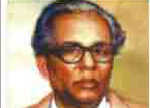Zainul Abedin’s 97th birth anniversary observed
 Yesterday marked the 97th birth anniversary of Shilpacharya Zainul Abedin (1914-1976). The Faculty of Fine Arts, University of Dhaka and several cultural organisations have arranged programmes to celebrate the birth anniversary of the maestro.
Yesterday marked the 97th birth anniversary of Shilpacharya Zainul Abedin (1914-1976). The Faculty of Fine Arts, University of Dhaka and several cultural organisations have arranged programmes to celebrate the birth anniversary of the maestro.
On the occasion, a three-day long festival is now on at the Charukala (Faculty of Fine Arts, DU) premises. The festival features a ‘mela’, musical soiree, discussion and an award giving event. AAMS Arefin Siddique, Vice Chancellor of Dhaka University was present as chief guest at the opening ceremony of the festival on December 29. Begum Jahanara Abedin (widow of Zainul Abedin) inaugurated the festival. Professor Emdadul Haque Mohammad Matlub Ali, Dean of the Faculty of Fine Arts, Harun-ur Rashid, Pro Vice-Chancellor of Dhaka University; Professor Dr. Mizanur Rahman, Treasurer of Dhaka University, among others, were present at the festival. The festival ends tomorrow.
This year, the organisers honoured two leading contemporary artistsQayyum Chowdhury and Murtaja Baseer with the ‘Shilpacharya Zainul Abedin Shammanana’ for their immense contribution to Bangladeshi art. AAMS Arefin Siddique handed over the awards to the recipient artists.
Born in Mymensingh, Zainul grew up in a serene landscape by the river Brahmaputra — the river being a source of inspiration to the artist from an early childhood. He gained admission in Calcutta Government Art School in 1933. After his graduation he became a teacher at the art school. A series of water colours that Zainul did as his tribute to the Brahmaputra River earned him the Governor’s Gold Medal in an all-India exhibition in 1938.
Dissatisfied with the stereotypes of Oriental style, Zainul moved on towards Realism and created his own style. He made a versatile use of lines in his interpretation of the everyday people. His “Famine Sketches,” a series of paintings Zainul made in 1943, addressed the dearth of food created by the Raj. Bengal was affected the most by the famine. That series earned Zainul international acclaim. Drawn in Chinese ink and brush on cheap packing paper, the series is a compilation of haunting images of intolerable cruelty and the utter helplessness of the masses dying slowly of hunger. His lines are very evocative and sensual. He is also famous for his landscapes, which mainly delve into scenic and panoramic beauty of rural Bengal. The works were mainly watercolours.
A well-known figure for his leadership qualities in organising artists and art movements, Zainul took the initiative to found the Government Institute of Arts and Crafts (now the Faculty of Fine Arts) in 1948 on Dhaka University campus, of which he was the founding principal.
In 1975, Zainul Abedin set up a folk museum at Sonargaon, and a permanent gallery in Mymensingh (Shilpacharya Zainul Abedin Sangrahashala) to display some of his works. He became actively involved in a movement to preserve the cultural heritage of Bengal.
Zainul died in 1976 in Dhaka.
-With The Daily Star input




















